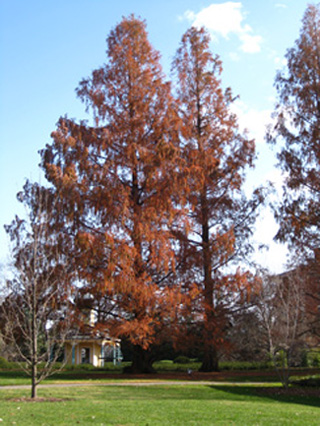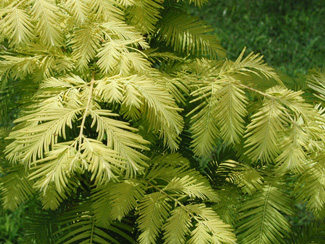Resource Library
Plant of the Week: Redwood, Dawn Golden, Gold Rush

Metasequoia glyptostroboides 11 09 MBG (4).jpg Dawn redwood is a fascinating tree with a colorful history that was first discovered through the fossil record.
Download High Resolution
Plants all have stories to tell but few have as detailed a record as the Dawn Redwood (Metasequoia glyptostroboides). This is because in a single war-ravaged decade – the 1940’s – Metasequoia went from being described as a Cenozoic fossil (the geological era after the extinction of the dinosaurs) by a Japanese paleobotanist, to its discovery by Chinese botanists as living trees along rice paddies in south-central China to its being grown as seedlings in Boston’s Arnold Arboretum.
Gold Rush dawn redwood is a golden-leafed form found in batch of seedlings in a Japanese nursery that is but a minor footnote to this exciting tale.
Dawn redwood is one of the living fossil plants that once occupied a wide swath of territory across North America, ranging from the Canadian arctic to North Dakota. The species seems to have flourished during the Paleocene-Eocene Thermal Maximum, about 56 million years ago, the last time the earth got really hot, really fast. So far four species of Metasequoia have been named, but three are known only as fossils, with the last thought to have disappeared about 6 million years ago.
Living dawn redwood trees were first spotted in 1941, but it took a couple years to associate the fossil specimen from Japan with the living trees in China. In 1948, Professors Cheng and Hu officially described and named the new species and Cheng – an alumnus of Harvard University – made contact with the staff of the Arnold Arboretum for a seed collecting expedition.
Dawn redwood, while the smallest of the redwoods, is still a big tree, often reaching 200 feet in its native homeland. It doesn't have the restrictive range once believed in China, now being found in more than 50 sites in three provinces. In the U.S., many of the original trees have reached higher than 80 feet over the last 60 years, but it is believed that Gold Rush, because it grows only about two-thirds as fast as the species, will be a smaller tree than the normal species. The overall form of the Gold Rush is the same as the species, which is that of a tall, narrow conifer with a flaring buttress trunk on older trees. In the fall of 1948, a seed collecting expedition was mounted and by the following year, 1,500 seedlings were

Metasequoia glyptostroboides 'Gold Rush'.jpg Gold Rush dawn redwood is a golden leafed selection that adds an ornamental twist to this interesting tree.
Download High Resolution
growing in Boston, Copenhagen and Amsterdam. With the fall of the bamboo curtain and Mao’s rise to power, no more was heard of the dawn redwood in China until 1980 when tensions relaxed and Western visitors were again welcomed.
Like the species, Gold Rush is deciduous with soft, feather-like leaves that are about 4 inches long. In mid spring leaves emerge a bright chartreuse color that settles down to a dull yellow during most of the summer. In the fall the leaves take on a russet-colored, reddish-brown before dropping to the ground.
Gold Rush was found in the Japanese nursery by a Dutch nurseryman who exported it to Holland, changed its name and began offering it worldwide in the 1990s.
Dawn redwood is a fast-growing specimen tree that is hardy in zones 5 through 8. It does best in a deep, moderately moist soil. During establishment and periods of prolonged drought, extra water should be provided, but established trees have stood up well throughout Arkansas without irrigation. It is ideal for use near streams or ponds. Because the tree gets big, care must be given to placing it where it has room to grow.
By: Gerald Klingaman, retired
Extension Horticulturist - Ornamentals
Extension News - April 18, 2014